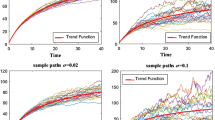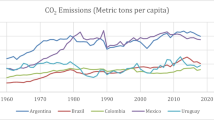Abstract
This paper examines the use of a bivariate stochastic Gamma diffusion model to represent the co-evolution of the stochastic variables CO2 emission and gross domestic product (GDP) in Spain. These variables were selected in view of the strong correlation between them. We compare the results obtained to those provided by the Gamma one-dimensional process with exogenous factors, taking CO2 emission as an endogenous variable and GDP as the exogenous factor. This methodology was applied to a real case, with two dependent variables: firstly, GDP and CO2 emission from the combustion of fossil fuels (gas, liquid and solid fuels) and cement manufacture in Spain. And secondly, with GDP and CO2 emission from the consumption and flaring of natural gas in Spain. The joint dynamic evolution of these factors is represented by the proposed model. In addition, a comparison is made with results obtained from fitting the data using the Gamma diffusion process with external factors, in which GDP is the variable containing the external information. This implementation was carried out on the basis of annual observations of the variables over the periods 1986–2008 and 1986–2009, respectively.




Similar content being viewed by others
References
Ait-Sahalia Y (2002) Maximum-likelihood estimation of discretely-sampled diffusion: a closed-form approximation approach. Econometrica 70:223–262
Ait-Sahalia Y (2008) Closed-form likelihood expansions for multivariate diffusions. Ann Stat 36:906–937
Anderson TW (1984) An introduction to multivariate statistical analysis, 2nd edn. Wiley, New York
Becker S, Germmer M, Jiang T (2006) Spatiotemporal analysis of precipitation trends in the Yangtze River catchment. Stoch Environ Res Risk Assess 20(6):435–444
Cantet P, Bacro JN, Arnaud P (2011) Using a rainfall stochastic generator to detect trends in extreme rainfall. Stoch Environ Res Risk Assess 25:429–441
Christakos G (2003) Soil behaviour under dynamic loading conditions: experimental procedures and statistical trends. Stoch Environ Res Risk Assess 17(3):175–190
Frank TD (2002) Multivariate Markov processes for stochastic systems with delays: application to the stochastic Gompertz model with delay. Phys Rev E 66(1):011914
Gutiérrez R, Angulo JM, González A, Pérez R (1991) Inference in lognormal multidimensional diffusion process with exogenous factors: application to modelling in economics. Appl Stoch Models Bus Ind 7:295–316
Gutiérrez R, González A, Torres F (1997) Estimation in multivariate lognormal diffusion process with exogenous factors. Appl Stat 4(1):140–146
Gutiérrez R, Gutiérrez-Sánchez R, Nafidi A (2004) Maximum likelihood estimation in multivariate lognormal diffusion process with a vector of exogenous factors. Monografías del Seminario Matemático García de Galdeano 31:337–346. http://www.ugr.es/ramongs/articulosenpdf/jaca2.pdf
Gutiérrez R, Gutiérrez-Sánchez R, Nafidi A (2008a) A bivariate stochastic Gompertz diffusion model: statistical aspects and application to the joint modelling of the gross domestic product and CO 2 emissions in Spain. Environmetrics 19:643–658
Gutiérrez R, Gutiérrez Sánchez R, Nafidi A, Merbouha A (2008b) A stochastic diffusion model based on the gamma density: statistical inference. Monografías del Seminario Matemtico Garca de Galdeano 34:117–125. http://www.ugr.es/ramongs/articulosenpdf/2008monografias34.pdf
Gutiérrez R, Gutiérrez-Sánchez R, Nafidi A (2008c) Trend analysis using nonhomogeneous stochastic diffusion processes. Emission of CO2; Kyoto protocol in Spain. Stoch Environ Res Risk Assess 22:57–66
Gutiérrez R, Gutiérrez Sánchez R, Nafidi A (2009) The trend of the total stock of the private car-petrol in Spain: stochastic modelling using a new gamma diffusion process. Appl Energy 86:18–24
Gutiérrez R, Gutiérrez-Sánchez R, Nafidi A (2010a) Statistical inference in the stochastic Gamma diffusion process with external information. Monografías del Seminario Matemático García de Galdeano 35:263–270. http://www.ugr.es/ramongs/articulosenpdf/2010monografias35.pdf
Gutiérrez R, Gutiérrez-Sánchez R, Nafidi A (2010b) A bivariate stochastic gamma diffusion model: statistical inference. Monografías del Seminario Matemático García de Galdeano 36:79–88. http://www.ugr.es/ramongs/articulosenpdf/2010monografias36.pdf
Gutiérrez R, Gutiérrez-Sánchez R, Nafidi A (2012) Detection, modelling and estimation of the non-linear trends by using a non-homogeneous Vasicek stochastic diffusion. Application to CO2 emissions in Morocco. Stoch Environ Res Risk Assess 26:533–543
Ramanathan R (2002) Combining indicators of energy consumption and CO2 emissions: a cross-country comparison. Int J Glob Energy Issues 17(3):214–227
Ramanathan R (2006) A multi-factor efficiency perspective to the relationships among world GDP, energy consumption and carbon dioxide emissions. Technol Forecast Soc Chang 73:483–494
Shao Q, Li Z, Xu Z (2010) Trend detection in hydrological time series by segment regression with application to Shiyang River Basin. Stoch Environ Res Risk Assess 24(2):221–233
Varughese MM (2013) Parameter estimation for multivariate diffusion systems. Comput Stat Data Anal 57:417–428
Xu J, Chen Y, Li W, Yang Y, Hong Y (2011) An integrated statistical approach to identify the nonlinear trend of runoff in the Hotan River and its relations with climatic factors. Stoch Environ Res Risk Assess 25:139–150
Zehna PW (1966) Invariance of maximum likelihood estimators. Ann Math Stat 37:744
Acknowledgments
The authors are very grateful to the editor and referees for constructive comments and suggestions. This research work was partially supported by IDI-Spain, Grants FQM 2006-2271 and MTM 2011-28962.
Author information
Authors and Affiliations
Corresponding author
Appendix
Appendix
Correlation function can be calculated for different times. When t 0 < s ≤ t and i ≠ j, then:
for t = s:
In the above example, we assume that the significant correlation is that which occurs at equal times, because the CO2 emissions for a given year would logically be related to the GDP for previous years, but are more strongly associated with the GDP for the current year.
Proof
The marginal conditional and non-conditional moments of order r (\({r\in {\mathbb{N}}^{*}}\)) can be obtained from the function generating the random vector
which follows the law \({\mathcal{N}}_2\left( \mu(s, t, x_s); (t-s)B\right), \) and is expressed as follows, for \({\lambda\in {\mathbb{R}}^2}\)
with
where
For particular values of the λ = (0, r)′ or λ = (r, 0)′ (\({r\in {\mathbb{N}}^{*}}\)), we obtain, for example, the marginal conditional trend functions of order r of the process and which have the following form, for i = 1, 2
and for λ = (r 1, r 2)′ (\({r_1, r_2 \in {\mathbb{N}}^{*}}\)), we obtain the joint conditional trend of the process
Assuming the initial condition P(x(t 0) = x t_0) = 1, the marginal non conditional trend of the process is expressed as
and the joint non conditional trend of the process is expressed as
Expressed in terms of δ(s, t) this is
and
For t 0 < s ≤ t the covariance function is
Using the fact that
we obtain
The non conditional marginal trend expressions for x 1(t) and x 2(s) are:
it is then deduced that
The marginal variance function of the process is:
In the same way
Therefore
In the same way
which can be expressed as
for i ≠ j and t 0 < s ≤ t.
Rights and permissions
About this article
Cite this article
Gutiérrez-Jáimez, R., Gutiérrez-Sánchez, R., Nafidi, A. et al. A bivariate stochastic Gamma diffusion model: statistical inference and application to the joint modelling of the gross domestic product and CO2 emissions in Spain. Stoch Environ Res Risk Assess 28, 1125–1134 (2014). https://doi.org/10.1007/s00477-013-0802-2
Published:
Issue Date:
DOI: https://doi.org/10.1007/s00477-013-0802-2
Keywords
- Bivariate stochastic
- Gamma diffusion process
- Likelihood estimation using discrete sampling
- Matrix differential calculus
- Normal and Wishart random matrices




